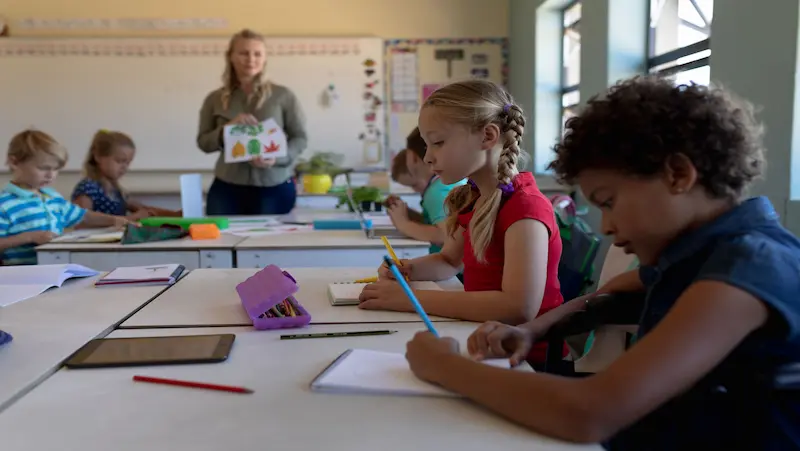Lesson planning is the backbone of effective teaching, providing a roadmap for educators to navigate through their instructional journey. It’s a dynamic tool that not only structures the classroom activities but also fuels engagement and learning. In today’s educational landscape, the availability of free lesson plans has become a game-changer, offering teachers a treasure trove of resources to enrich their teaching methodologies and engage students in innovative ways.
Lesson plans serve as guides that help educators organize their thoughts, objectives, and methodologies before stepping into the classroom. They act as blueprints, detailing what to teach, how to teach it, and the expected outcomes. These plans are essential in maintaining a cohesive and structured learning environment that supports students’ comprehension and retention of information.
Table of contents
- Benefits of Free Lesson Plans
- Types of Free Lesson Plans
- Finding Free Lesson Plans
- Lesson Plan Formats and Elements
- Using Technology in Lesson Planning
- Collaborative Lesson Planning
- Adapting Lesson Plans for Online Learning
- The Future of Free Lesson Plans
- Ensuring Equity and Accessibility
- Conclusion
- Frequently Asked Questions (FAQ’S)
Benefits of Free Lesson Plans
Reducing Workload and Saving Time
Free lesson plans, readily available online, alleviate the burden of creating curriculum content from scratch. Educators can modify and adapt existing plans, significantly reducing preparation time. This time-saving aspect allows teachers to focus more on refining instructional strategies and addressing individual student needs.
Enhancing Teaching Creativity
These plans serve as a catalyst for creativity, offering a pool of ideas that educators can tweak, personalize, and infuse with their teaching style, making lessons more engaging and impactful. By integrating innovative activities or approaches from various lesson plans, teachers can design dynamic learning experiences that captivate students’ attention and foster a love for learning.
Bridging Resource Gaps
For teachers facing resource limitations, free lesson plans provide access to high-quality materials, activities, and strategies that might otherwise be unavailable due to budget constraints. These learning resources bridge the gap between resource-rich and resource-poor classrooms, ensuring that all students receive equitable opportunities for a quality education.
Types of Free Lesson Plans
Curriculum-Based Plans
Aligned with educational standards, these plans cover a range of subjects and grade levels, ensuring that lessons are in sync with academic requirements. They offer a structured approach to learning, guiding teachers in delivering comprehensive and well-rounded content that meets curriculum objectives.
Subject-Specific Plans
Focused on individual subjects, these plans dive deeper into specific topics, catering to the nuances and intricacies of each subject area. This specificity enables teachers to delve into subject matter deeply, providing students with a thorough understanding of the material.
Cross-Curricular Integration
Encouraging interdisciplinary learning, these plans foster connections between various subjects, creating a holistic educational experience for students. By intertwining subjects like science and art or history and literature, students gain a broader perspective and see how different disciplines relate to each other in the real world.
Finding Free Lesson Plans
Online Resources and Platforms
Websites and platforms such as Khan Academy, Teach Starter, and PBS LearningMedia offer a vast collection of free, ready-to-use lesson plans across various subjects and grade levels. These platforms host a plethora of resources, ranging from worksheets and activities to multimedia content, catering to diverse teaching needs.
Teacher Communities and Forums
Engaging with fellow educators through communities like TeachersPayTeachers, Pinterest, or educational forums provides access to shared resources, insights, and collaborative ideas. Networking within these communities encourages the exchange of teaching strategies and promotes continuous professional growth.
Customizing Lesson Plans
Educators can personalize existing lesson plans to suit their teaching style, student needs, and classroom dynamics, ensuring relevance and effectiveness using different learning strategies. By adding supplementary materials, adjusting activities, or incorporating personal anecdotes, teachers can create a unique teaching experience tailored to their students’ interests and abilities.

Lesson Plan Formats and Elements
Structure and Components
Lesson plans typically include sections such as objectives, materials, procedures, assessments, and extensions to guide teachers through the teaching process. This structured format provides a clear roadmap for educators to follow, ensuring that instructional goals are met effectively.
Objectives and Outcomes
Clearly defined learning objectives help focus teaching strategies and enable teachers to evaluate whether students have achieved the desired outcomes. When objectives are explicit, students gain a better understanding of what they’re expected to learn, promoting a more purposeful and directed learning experience.
Assessment and Evaluation
Incorporating assessment strategies within lesson plans aids in gauging student understanding and tailoring future instruction accordingly. Effective assessment methods allow educators to track students’ progress, identify learning gaps, and adjust teaching approaches for better outcomes.
Using Technology in Lesson Planning
Online Tools and Apps
Utilizing tools like Google Classroom, Nearpod, or Edpuzzle facilitates interactive and engaging lessons, making learning more enjoyable for students. Integrating technology not only captures students’ interest but also equips them with digital literacy skills essential for the modern world.
Virtual Reality and Interactive Resources
Immersive technologies offer unique experiences, enabling students to explore concepts beyond traditional teaching methods. Virtual reality and interactive resources bring abstract concepts to life, enhancing students’ comprehension through experiential learning.
Gamification and Engagement
Incorporating elements of gamification through platforms like Kahoot! or Quizizz fosters a competitive yet fun learning environment. Gamified learning motivates students, encouraging active participation and enhancing their retention of information.
Collaborative Lesson Planning
Team Teaching and Co-Planning
Collaborating with colleagues allows educators to pool their expertise, leading to innovative lesson plans that benefit from multiple perspectives. Collaborative planning not only enriches teaching practices but also cultivates a supportive and collaborative school culture.
Sharing Lesson Plans within School Communities
Within school settings, sharing resources fosters a culture of collaboration and continuous improvement among educators. It encourages a sense of teamwork, where teachers collectively contribute to each other’s growth and success.
Collaborating with Teachers Worldwide
Connecting with educators globally through platforms like Twitter chats or international conferences opens doors to diverse teaching methodologies and perspectives. Global collaboration promotes cultural understanding and equips educators with a broader spectrum of teaching strategies.
Adapting Lesson Plans for Online Learning
Shifting to Virtual Classrooms
With the shift to online learning, adapting lesson plans for virtual classrooms involves leveraging digital tools and interactive platforms. Creating engaging online activities and leveraging multimedia content is crucial in sustaining student engagement in remote settings.
Interactive Platforms and Tools
Exploring platforms like Zoom, Microsoft Teams, or Flipgrid enhances engagement and interaction in online learning environments. Utilizing these tools effectively creates an interactive and participatory virtual classroom experience.
Challenges and Opportunities
Adapting lesson plans for online learning comes with challenges such as connectivity issues but also presents opportunities for innovative teaching methods. Overcoming these challenges fosters resilience and encourages educators to explore new and effective ways of teaching in digital environments.
The Future of Free Lesson Plans
Technological Advancements and Trends
Modern education system in a transition phase. As technology evolves, incorporating artificial intelligence and personalized learning experiences will shape the future landscape of lesson planning. The integration of adaptive learning tools and AI-driven analytics will cater to individual student needs, enhancing the efficacy of lesson plans.
Global Accessibility and Inclusivity
Efforts to make educational resources more accessible and inclusive globally will play a pivotal role in shaping the future of free lesson plans. Embracing diverse cultural perspectives and ensuring multilingual resources promotes inclusivity in education.
Open Education Resources
The proliferation of open education resources will continue to expand, providing educators with a wealth of diverse teaching materials. Open access to quality educational resources supports a collaborative and interconnected global education community.
Ensuring Equity and Accessibility
Resources for Low-Income Schools
Initiatives to provide additional support and resources to schools facing financial constraints promote equity in access to quality education. Bridging the resource gap ensures that all students, regardless of socio-economic background, have equal opportunities to thrive academically.
Bridging the Digital Divide
Addressing the digital divide through initiatives like providing devices and internet access ensures equal opportunities for all students. Equitable access to technology is crucial in leveling the playing field for students from diverse socio-economic backgrounds.
Multilingual and Multicultural Lesson Plans
Developing lesson plans that cater to diverse linguistic and cultural backgrounds fosters an inclusive learning environment. Recognizing and embracing cultural diversity enriches students’ learning experiences and promotes empathy and understanding among peers.
Conclusion
In conclusion, the availability of free lesson plans empowers educators by providing valuable resources, fostering creativity, and bridging gaps in teaching materials. As technology continues to advance and educational landscapes evolve, leveraging these resources while ensuring accessibility and inclusivity will pave the way for a brighter future in education.
Empowering teachers with free lesson plans not only enhances the teaching experience but also enriches the learning journey for students, ultimately shaping a more robust and equitable educational system for generations to come. By embracing innovation, collaboration, and inclusivity, educators can harness the potential of free lesson plans to create impactful and inspiring learning environments.
To get your hands on more educational and free resources on coding for kids, robotics for kids, financial education for kids, etc., do check out the BrightCHAMPS Page now!
Frequently Asked Questions (FAQ’S)
A1. You can find reliable free lesson plans from various sources online. Educational websites, teaching forums, educational resource databases, and teacher communities often offer free, quality lesson plans. Platforms like Teachers Pay Teachers, Khan Academy, PBS LearningMedia, and Teach Starter are excellent starting points.
A2. Adapting lesson plans for your students’ needs involves understanding their learning styles, strengths, and weaknesses. Modify content, activities, and assessments to accommodate diverse learners. Differentiate instruction by using various teaching methods, providing additional resources, or adjusting the pace or complexity of the lesson.
A3. Many free lesson plans are aligned with educational standards, but not all. Check for alignment with your specific curriculum or educational standards by reviewing the objectives, learning outcomes, and associated materials within the lesson plan.
A4. Free lesson plans can supplement traditional textbooks, offering diverse teaching strategies and resources. However, they might not cover all the content found in textbooks. They serve as valuable aids but might not fully replace the comprehensive nature of textbooks.
A5. When citing free lesson plans, include the author’s name, lesson title, source (website or platform), publication or creation date, and URL if applicable. Follow citation guidelines such as APA, MLA, or Chicago style, ensuring proper credit to the original creator.


 We are an army of educators and passionate learners from BrightChamps family, committed to providing free learning resources to kids, parents & students.
We are an army of educators and passionate learners from BrightChamps family, committed to providing free learning resources to kids, parents & students.












